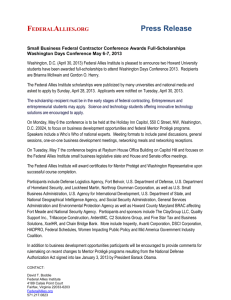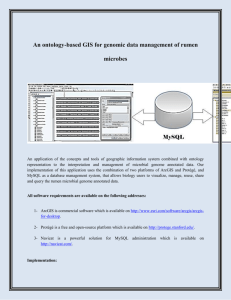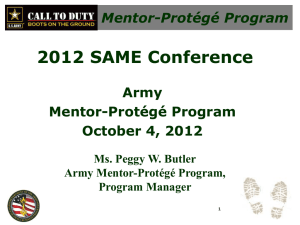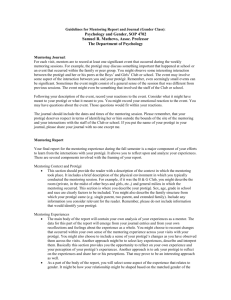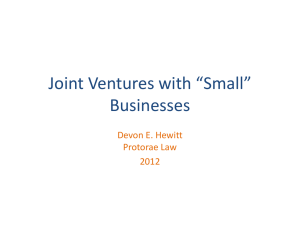After Sarajevo: Explaining the Blank Check
advertisement
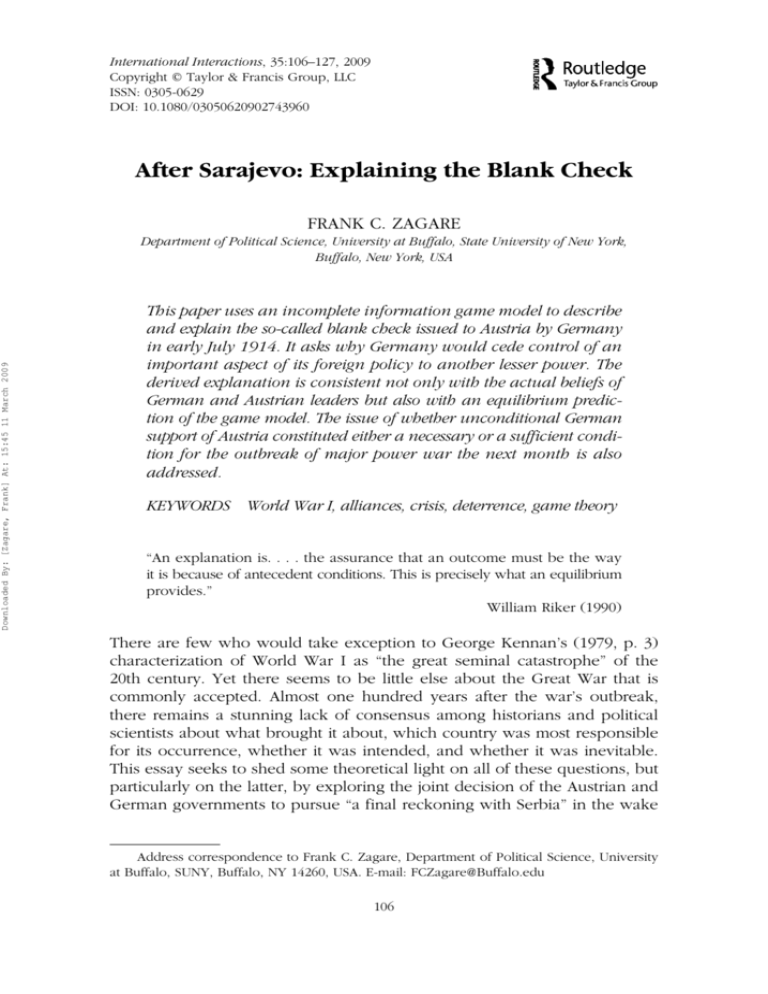
International Interactions, 35:106–127, 2009 Copyright © Taylor & Francis Group, LLC ISSN: 0305-0629 DOI: 10.1080/03050620902743960 After Sarajevo: Explaining the Blank Check 1547-7444 Interactions, 0305-0629 GINI International Interactions Vol. 35, No. 1, Feb 2009: pp. 0–0 After F. C. Zagare Sarajevo: Explaining the Blank Check FRANK C. ZAGARE Downloaded By: [Zagare, Frank] At: 15:45 11 March 2009 Department of Political Science, University at Buffalo, State University of New York, Buffalo, New York, USA This paper uses an incomplete information game model to describe and explain the so-called blank check issued to Austria by Germany in early July 1914. It asks why Germany would cede control of an important aspect of its foreign policy to another lesser power. The derived explanation is consistent not only with the actual beliefs of German and Austrian leaders but also with an equilibrium prediction of the game model. The issue of whether unconditional German support of Austria constituted either a necessary or a sufficient condition for the outbreak of major power war the next month is also addressed. KEYWORDS World War I, alliances, crisis, deterrence, game theory “An explanation is. . . . the assurance that an outcome must be the way it is because of antecedent conditions. This is precisely what an equilibrium provides.” William Riker (1990) There are few who would take exception to George Kennan’s (1979, p. 3) characterization of World War I as “the great seminal catastrophe” of the 20th century. Yet there seems to be little else about the Great War that is commonly accepted. Almost one hundred years after the war’s outbreak, there remains a stunning lack of consensus among historians and political scientists about what brought it about, which country was most responsible for its occurrence, whether it was intended, and whether it was inevitable. This essay seeks to shed some theoretical light on all of these questions, but particularly on the latter, by exploring the joint decision of the Austrian and German governments to pursue “a final reckoning with Serbia” in the wake Address correspondence to Frank C. Zagare, Department of Political Science, University at Buffalo, SUNY, Buffalo, NY 14260, USA. E-mail: FCZagare@Buffalo.edu 106 After Sarajevo: Explaining the Blank Check 107 of the assassination of Archduke Franz Ferdinand and his morganatic spouse in Sarajevo on June 28, 1914. The analysis has important implications not only for an understanding of the particular events that took place subsequently in late July and early August 1914 but also for a number of issues that arise in the context of developing causal explanations of interstate conflict. I begin with some historical perspective. Downloaded By: [Zagare, Frank] At: 15:45 11 March 2009 BACKGROUND The formal strategic partnership between Germany and Austria-Hungary dates to 1879 when Imperial Germany’s first Chancellor, Otto von Bismarck, accepted Austria’s terms for a defensive alliance. For Bismarck, the alliance served a variety of purposes. His immediate goal was to deflect Russian pressures against Austria in the Balkans that, if resisted, might draw Germany into a war with Russia or, if not resisted, might push Austria into an antiGerman alliance with Russia or, even worse, France (Langer, 1950, p. 180). Eventually, however, Bismarck hoped to bring Russia into a conservative alliance with Austria that would, in effect, isolate France. Finally, Bismarck hoped to convince other European states that Germany was no longer a revisionist state. Bismarck’s policy was a success. In 1881 the Three Emperor’s League linking Germany, Austria-Hungary, and Russia was revived. And in 1887 Bismarck negotiated the Reinsurance Treaty with Russia. This secret agreement was a three-year pact that obligated German neutrality in the event that Austria-Hungary attacked Russia, and Russian neutrality in the event that Germany was attacked by France. The Reinsurance Treaty was the capstone of “the Bismarkian system, . . . a network of interlocking alliances, carefully balanced and kept in order by the master diplomat in Berlin” (Massie, 1991, p. 82). So sound was this system that it survived for almost a quarter of a century after Bismarck left office, despite several acute crises and a number of minor power wars. In the end, however, the system did in fact collapse due, in no small part, to the ineptitude of German diplomacy. The problems began immediately. Almost as soon as Bismarck was driven from office by the new German Kaiser, Wilhelm II, in 1890, his successors in the Wilhelmstrasse allowed the Reinsurance Treaty to lapse. The goal at the time was to forge a new alliance in which Russia was replaced by Great Britain. At the same time, by adopting a more aggressive approach to world affairs (Weltpolitik), the German foreign policy establishment hoped to capture “its place in the sun.” The new policy did not work out. Cut adrift, Russia had little choice but to align more closely with France. By 1894, Russia and France were in a formal alliance and committed to each other’s defense should either be attacked by Downloaded By: [Zagare, Frank] At: 15:45 11 March 2009 108 F. C. Zagare Germany. As Kagan (1995, p. 126) succinctly put it, “Bismarck’s worst nightmare had become a reality.” But it actually got worse than this. Germany’s New Course, but especially its aggressive naval program of building state of the art battleships (or Dreadnoughts), both challenged and alienated the British. The German leadership hoped and expected that Britain, when faced by a surging Germany, would seek accommodation. But instead, Britain gradually moved closer to France. By 1904, the two erstwhile enemies reached an agreement, called the Entente Cordiale, that settled a number of colonial disputes and, more generally, brought their foreign policies into closer alignment. It was only a matter of time until all the dots were connected: in 1907, Great Britain and Russia reached an accord designed to reduce the intensity and scope of their competition in Asia. Isolated diplomatically, Germany became overly reliant on its strategic relationship with Austria-Hungary which, after the Ottoman Empire, was generally considered the next “sick man of Europe.” Thus, when in 1908–1909 Austria was challenged by Russia, German policymakers “felt they had no choice but to support Austria in its bid to annex Bosnia and Herzegovina” (Mercer, 1996, p. 125; see also Kagan, 1995, p. 162–63.) Still, German support was not automatic. During the First Balkan war, for example, German policymakers declined an Austrian request for contingent military support. But in 1914, things went the other way again when a “blank check” was issued in Berlin and cashed, after an inexplicable delay, in Vienna. TRIPARTITE CRISIS GAME To explain the blank check, I draw on a three-person game model of extended deterrence and analyze it under incomplete information. This model, called the Tripartite Crisis Game model, is depicted graphically in Figure 1. Although it was originally developed to capture the strategic dynamic that conditioned German-Austrian alliance negotiations in 1879 (Zagare and Kilgour, 2003), it is equally pertinent to the vexing political predicament that confronted German and Austrian decisionmakers well after Bismarck left the scene. As it turned out, and as will be seen shortly, the stark choice that the Iron Chancellor sought to deflect in 1879 simply did not go away. As Figure 1 reveals, there are three players in the model, Challenger, Defender, and Protégé. Challenger begins play by deciding to make a demand. If no demand is made, the outcome called Status Quo obtains. But if a demand is made, Protégé must decide whether to concede or to hold firm. Challenger Wins when Protégé concedes. But when Protégé holds firm, Defender chooses whether to support or withhold support from Protégé. If Defender supports Protégé, Challenger either backs down or presses on, 109 After Sarajevo: Explaining the Blank Check Challenger Node 1 Demand Not Demand Status Quo Protégé Concede (1 – y) Node 2 Hold Firm (y) Defender Challenger Wins Downloaded By: [Zagare, Frank] At: 15:45 11 March 2009 Not Support (1 – z) Protégé Nodes 4a and 4b Realign Not Realign Protégé Realigns Node 3 Support (z) Challenger Back Down Press On Conflict Protégé Loses Challenger Concedes FIGURE 1 Tripartite crisis game. leading to either Challenger Concedes or Conflict. But if Defender withholds support, Protégé must decide whether or not to realign. In either case, an abandoned Protégé is forced to make concessions to Challenger. Protégé Loses when it decides not to seek a new strategic partner. But when Protégé Realigns, Defender loses as well. The preference assumptions that will be used to guide the analysis of the Tripartite Crisis Game model and its subsequent application to the decisionmaking process in the aftermath of Sarajevo are summarized in Table 1. Challenger’s preferences are listed in the first column, from best to worst, Protégé’s in the second column, and Defender’s in the third. For example, the assumption is that Challenger most prefers Challenger Wins, next-most prefers Protégé Realigns, and so on. No fixed preference assumption is made for outcomes contained in the same cell of Table 1. Thus, in what follows, Protégé could prefer Protégé Loses to Protégé Realigns or the reverse. Similarly, Defender’s preference between Conflict and Protégé Realigns is left open. Protégé’s and 110 F. C. Zagare TABLE 1 Preference Assumptions for the Tripartite Crisis Game Challenger: Downloaded By: [Zagare, Frank] At: 15:45 11 March 2009 Challenger Wins Protégé Realigns Protégé Loses Status Quo Conflict Challenger Concedes Protégé: Defender: Status Quo Challenger Concedes Conflict Challenger Wins Protégé Loses or Protégé Realigns Status Quo Challenger Concedes Challenger Wins Protégé Loses Conflict or Protégé Realigns Defender’s relative preferences for these two paired outcomes are the crucial explanatory variables of the version of model explored in this essay. To be sure, the preference assumptions arrayed in Table 1 do not exhaust the set of reasonable possibilities. With three players and six outcomes, there are 6 × 6 × 6 = 216 different preference combinations that could be used to analyze the Tripartite Crisis Game. Not all of these combinations, though, are theoretically interesting. Of those that are, some are inconsistent, empirically, with the strategic conundrum that conditioned German and Austro-Hungarian decisionmaking in 1914. The specific assumptions made above are the exception. They are motivated by both theoretical and empirical considerations. As discussed below, Challenger’s preferences have been fashioned to ensure that deterrence is both relevant and possible. And Defender’s preferences have been formulated both to accentuate the “deterrence versus defense” dilemma (Snyder and Diesing, 1977, p. 438) that confronted decisionmakers in Berlin from 1879 to the outbreak of the Great War and to reflect the fact that until 1914 German policy was driven less by the issues at stake in the Balkans than by the necessity to preserve the political and military viability of Germany’s only reliable strategic partner. For the most part, the preference assumptions are straightforward and self-explanatory.1 Nonetheless, a few are not. Consider first Challenger’s preferences. In the Tripartite Crisis Game, Challenger’s primary objective, as Bismarck saw Russia’s in 1879, is to obtain a concession from Protégé. Three outcomes of the Tripartite Crisis Game offer Challenger a clear improvement of the Status Quo. Challenger’s preference for these outcomes over the others is taken as a given. Of these, the assumption is that: Challenger Wins >Ch Protégé Realigns >Ch Protégé Loses, where >Ch means “is preferred to by Challenger.” Challenger Wins brings immediate gratification and is relatively costless. Protégé Realigns humiliates Defender. Protégé Loses does not. Challenger’s postulated preference for Protégé Realigns over Protégé Loses means that Protégé’s alignment policy matters, not only to Defender (see below), but to Challenger as well.2 Of the remaining three outcomes, the assumption is that Challenger prefers the Status Quo to Conflict and Conflict to Challenger Concedes. The first assumption leaves open the possibility that deterrence can succeed; the second Downloaded By: [Zagare, Frank] At: 15:45 11 March 2009 After Sarajevo: Explaining the Blank Check 111 guarantees that it can fail. A Challenger with a preference for Conflict over Challenger Concedes is called determined.3 Determined Challengers are highly motivated. Consider now Protégé’s preferences. Protégé’s presumed objective is to avoid acceding to Challenger. Among the three outcomes that do not involve concession, the assumption is that Status Quo >Pro Challenger Concedes >Pro Conflict, where >Pro means “is preferred to by Protégé.” Status Quo involves no loss or evident cost, whereas when Challenger Concedes Protégé incurs an obligation to Defender. With Conflict, on the other hand, there are additional costs as well as the risk of an unfavorable outcome. Of the three outcomes that involve an outright loss, Protégé is assumed to most prefer Challenger Wins on the grounds that an immediate concession is less costly than a later concession made under duress. Protégé’s relative preference between the remaining two outcomes determines its type. A Protégé that least prefers to realign (i.e., prefers Protégé Loses to Protégé Realigns) is called loyal; a Protégé with the opposite preference is disloyal. Finally, consider Defender’s situation. Defender is stuck between a rock and a hard place. Ceteris paribus, it would like to avoid Conflict and, at the same time, preserve its bond with Protégé. The rub, of course, is that Defender might have to threaten to fight to save the relationship. Of course, neither cost is incurred when the Status Quo prevails. The same is true when Challenger Concedes. But since deterrence is taken to be Defender’s primary motivation, the assumption is that Status Quo >Def Challenger Concedes, where >Def means “is preferred to by Defender.” As well, it is taken as axiomatic that Challenger Concedes >Def Challenger Wins >Def Protégé Loses >Def Protégé Realigns. A common negative shared by the latter three outcomes is indirect: the concession that Protégé is pressured to make to Challenger. At Challenger Wins, however, Defender’s treachery is not transparent. At Protégé Loses, Defender’s type is apparent, but at least its relationship with Protégé, albeit weakened, is maintained. At Protégé Realigns, Protégé defects and Defender incurs a significant strategic cost. Defender’s evaluation of Conflict relative to the other outcomes remains to be discussed. To reflect Defenders relative lack of interest in the concessions that Protégé might be forced to make (i.e., the issues at stake), the assumption will be that Protégé Loses >Def Conflict. Left open, however, is Defender’s willingness to fight in order to maintain its strategic relationship with Protégé. Defenders that prefer Conflict to Protégé Realigns are called staunch; those with the opposite preference are called perfidious. CALIBRATING THE MODEL In using the Tripartite Crisis Game—or any game model for that matter—to analyze a real world event, one must caution against too literal an interpretation Downloaded By: [Zagare, Frank] At: 15:45 11 March 2009 112 F. C. Zagare of the nomenclature used to describe the players, their choices and the outcomes. It is rarely the case that any model will conform exactly to the messy world of politics, interstate or otherwise, where choices are made by fallible human beings suffering from a variety of perceptual, cognitive, psychological, and related limitations in a wide variety of strategic contexts. All of which is to say that a few emendations to the Tripartite Crisis Game must be made before it can be used to explore the decisionmaking process in Vienna immediately after the assassination in Sarajevo. I begin with the specification of the players. Assuming that assassination of Franz Ferdinand represented a clear challenge to the integrity of the Austro-Hungarian empire, which was the way this event was viewed in Vienna and, to a lesser extent, in Berlin, the association of two of the players in the model world with their real world analogues is straightforward. After Sarajevo, Austria-Hungary (Protégé) had to decide whether to hold firm by taking steps, whatever they might be, to eliminate the threat posed by Serbia, or to concede the issue and attempt to preserve the monarchy by reforming internally. Of course, if Austria-Hungary sought reprisal against Serbia, Germany (Defender) would have to decide whether to support its partner. From Berlin’s point of view, support clearly brought with it the risk of war, while nonsupport risked the rupture of the Dual Alliance (Farrar, 1972). Clearly, the strategic dilemma that first confronted Bismarck in 1879 was a perennial problem for the German government. While no great conceptual leap is required to connect, plausibly, the roles played by Austria-Hungary and Germany with two of the players in the Tripartite Crisis Game, the association of a real-world actor with the player named Challenger is more problematic. Since Challenger makes two choices in the Tripartite Crisis Game, it is important to treat this question seriously (Riker and Ordeshook, 1973, p. 239). If a model is to tell us anything at all about a real world interaction, it must bear a reasonably close resemblance to the event in question. Player assignments should not be made willy-nilly. With this in mind, consider first the initial move made by Challenger in the Tripartite Crisis Game. From Vienna’s vantage point, Serbia was clearly viewed as the challenger. As Kagan (1995, p. 188) points out, “the Austrians did not doubt Serbian complicity” in the Archduke’s murder. Regardless, there is little hard evidence to support this judgment. To be sure, the assassin, Gavrilo Princip, was a Bosnian Serb. But his action was neither initiated nor sanctioned by the Belgrade government, although Serbian Prime Minister Nicola Pasic likely had foreknowledge of the plot (Fromkin, 2004, chs. 19, 24). Thus, it strains credulity to consider Serbia the node 1 decisionmaker. In fact, it would seriously distort reality to consider any real world government to have made the initial choice in the game. On the other hand, the assassination of the heir apparent to the AustroHungarian throne was real and could not be ignored, irrespective of who devised the plan or how it was implemented. How, then, can the event that Downloaded By: [Zagare, Frank] At: 15:45 11 March 2009 After Sarajevo: Explaining the Blank Check 113 is generally considered to have brought on the Great War be handled? One way, indeed the most defensible way, is to consider the assassination as a random event or as an act of nature. Given this interpretation, the choice at node 1 can be treated as a fait accompli that simply precipitated the proper subgame that commences with Protégé’s (i.e., Austria’s) choice at node 2. Of course, Challenger also makes a choice at node 4b, so we are not quite off the hook yet. Challenger’s choice arises in the context of Protégé’s node 2 decision to hold firm and Defender’s node 3 decision to support Protégé. Given these prior decisions, Challenger at node 4b must decide whether to accept the challenge (press on) or concede (back down). Pressing on implies conflict. Backing down implies concession and defeat. But who, if anyone, faced this decision in July 1914? Since, for the moment, we are primarily interested in explaining Austria’s node 2 choice, we must answer this question as seen by Austria-Hungary. The usual suspects are Russia and Serbia. Neither, however, will do. First consider Russia. From Vienna’s point of view, in early July Russia was simply not a player. As Williamson (1983, p. 27) points out, “possibly the most striking feature of the Hapsburg decision-making process in July 1914 was its failure to think seriously anew about Russia’s position and its possible intervention. The policymakers acted as if Russia did not exist.”4 Below I explain why the likely Russian reaction was ignored by Austrian Foreign Minister Berchtold and other key decisionmakers at the Ballhausplatz, the home of Austria-Hungary’s Foreign Ministry. Consider now Serbia. Like Russia, Serbia’s response was not seriously considered by decisionmakers in Vienna. In fact, the ultimatum it delivered on July 23 was carefully crafted to leave Belgrade with little choice but to reject it (Geiss, 1967, p. 114). It was, as British Foreign Minister Edward Grey characterized it, “the most formidable document [he] had ever seen addressed by one State to another that was independent” (Gooch and Temperley, 1926, IX, p. 73). Of course, rejection implied war—which was Vienna’s preferred outcome. Assuming that no real world actor made an actual choice at node 1, and that the Austrian ultimatum—issued with Germany’s backing—implied Conflict, the Tripartite Crisis Game reduces to the proper subgame game highlighted in Figure 2. The equilibrium structure of this subgame, called the Protégé-Defender subgame, is used to look for clues to the behavior of German and Austrian decisionmakers in the aftermath of Sarajevo. Before proceeding, however, there is one issue that needs to be clarified. Recall that previously the assumption was made that Protégé preferred Challenger Concedes to Conflict. In the context of the general strategic problem that framed Austrian foreign policy after the Congress of Berlin (1878), this is the proper assumption. But in the context of the July Crisis, the opposite assumption would be more appropriate. One might well ask, then, whether this lack of congruence between the initial and the present assumptions calls into question the models’ fit with the facts on the ground? 114 F. C. Zagare Challenger Not Demand Node 1 Demand Status Quo Protégé Concede (1 –y) Hold Firm (y) Node 3 Challenger Wins Downloaded By: [Zagare, Frank] At: 15:45 11 March 2009 Node 2 Defender ProtégéDefender Subgame Not Support (1 – z) Node 4a Support (z) Protégé Realign Protégé Realigns Conflict Not Realign Protégé Loses FIGURE 2 Tripartite crisis game with determined challenger. The short answer is that, in this instance, the discrepancy is of little theoretical moment. The reason is straightforward. The formal analysis that follows rests on the supposition that Conflict will follow if Protégé holds firm and is supported by Defender at node 3. Therefore, Protégé’s relative preference between Challenger Concedes and Conflict has no bearing on the formal results. All of which suggests that the Protégé-Defender subgame can be considered a reasonably close approximation of the alliance game played between Austria-Hungary and Germany in early July 1914. PRÉCIS5 In this section I offer a brief (informal) summary of the equilibrium structure of the Protégé-Defender subgame, given the preference assumptions Downloaded By: [Zagare, Frank] At: 15:45 11 March 2009 After Sarajevo: Explaining the Blank Check 115 listed in Table 1. Since Challenger does not make a choice in the subgame, its preferences are immaterial. But Defender’s and Protégé’s clearly are. In what follows, Defender and Protégé are assumed to possess private information about the preferences that establish their type. Thus, the Protégé-Defender subgame will be analyzed as a game of incomplete information. The accepted standard of rational behavior in dynamic (i.e., extensiveform) games with incomplete information is perfect Bayesian equilibrium. A perfect Bayesian equilibrium specifies an action choice for every type of every player at every decision node or information set belonging to the player; it must also indicate how each player updates its beliefs about other players’ types in the light of new information obtained as the game is played out. Even an informal summary of the perfect Bayesian equilibria of the Protégé-Defender subgame requires a few additional assumptions and a bit of notation. To model the consequences of the players’ uncertainty about Defender’s and Protégé’s type, assume now that Defender is staunch with probability pDef (where 0 < pDef < 1), that Protégé is disloyal with probability pPro (where 0 < pPro < 1), and that the values of pDef and pPro are known to all the players. Of course, Defender and Protégé are assumed to know the realized value of pDef and pPro, respectively, that is, they are assumed to know their own type (preferences). To begin, observe that Protégé’s node 4a choice is strictly determined by its type. A disloyal Protégé always realigns; a loyal Protégé never does. Note as well that before Defender can make a choice at node 3, it will observe Protégé’s prior action choice at node 2. Defender can use this new information to reassess Protégé’s type (and likely choice) at node 4a. Since Defender’s choice at node 3 depends, in part, on its assessment of Protégé’s type, the additional information it obtains is useful. By contrast, any observations that Protégé makes before choosing at node 4a will be beside the point. After all, Protégé’s choice at this decision node is strictly determined by its type. Given these considerations, it follows that a perfect Bayesian equilibrium of the Protégé-Defender subgame will consist of a five-tuple of probabilities [yD, yL; zS, zP, q] where: yD = the probability that a disloyal Protégé will choose to hold firm at node 2 yL = the probability that a loyal Protégé will choose to hold firm at node 2 zS = the probability that a staunch Defender will choose to support Protégé at node 3 zP = the probability that a perfidious Defender will choose to support Protégé at node 3 q = Defender’s updated probability that Protégé is disloyal, given that Protégé holds firm at node 2. Downloaded By: [Zagare, Frank] At: 15:45 11 March 2009 116 F. C. Zagare The first four probabilities are strategic variables describing Protégé’s and Defender’s choices, contingent on their type. The fifth probability is the a posteriori probability, updated by Defender once Protégé’s choice to hold firm at node 2 has been observed.6 As Table 2 shows, there are four plausible, non-transitional, perfect Bayesian equilibria in the subgame, none of which coexist.7 Of the four, one is labeled Settlement. At any Settlement equilibrium, Protégé always concedes at node 2 (i.e., yD = yL = 0). In consequence, when a Settlement equilibrium is in play, the outcome is always Challenger Wins. Anticipating abandonment by Defender, Protégé simply accepts defeat—as Serbia did in 1908 when it was forsaken by Russia. Settlement equilibria exist only when Defender is very likely perfidious. The Separating perfect Bayesian equilibria separates the players strictly by type: a disloyal Protégé always holds firm at node 2; a loyal Protégé always concedes (i.e., yD = 1, yL = 0). Similarly, a staunch Defender always supports Protégé at node 3; a perfidious Defender never does (i.e., zS = 1, zP = 0). The outcome of the Protégé-Defender subgame under a Separating equilibrium, then, is Challenger Wins when Protégé is loyal; Conflict when Protégé is disloyal and Defender is staunch; and Protégé Realigns when Protégé is disloyal and Defender is perfidious. Separating equilibria exist when uncertainty about Defender’s type is high, that is, when it is neither likely staunch or likely perfidious. Under the Hold Firm perfect Bayesian equilibria, Protégé always holds firm at node 2 (i.e., yD = yL = 1). Hence its name. Staunch Defenders always support Protégé, Perfidious Defenders always withhold support (i.e., zS = 1, zP = 0). Thus, the outcome under a Hold Firm equilibrium is Conflict if Defender is staunch. When Defender is Perfidious the outcome depends on Protégé’s type: Protégé Loses when Protégé is loyal; Protégé Realigns when Protégé is disloyal. Hold Firm equilibria exist when Protégé is likely disloyal and Defender is likely staunch. TABLE 2 Plausible Perfect Bayesian Equilibria of Protégé-Defender Subgame with Incomplete Information (Adapted from Zagare and Kilgour, 2003) Equilibrium Strategic and belief variables Protégé Settlement Separating Hold Firm Bluff Defender yD yL zS zP q 0 1 1 1 0 0 1 • 1 1 1 — 0 0 0 0 >d1 1 pPro d1 Key: “•” = fixed value between 0 and 1; “—” = value not fixed although some restrictions apply. After Sarajevo: Explaining the Blank Check 117 The final form of perfect Bayesian equilibrium in the Protégé-Defender subgame is called Bluff. At a Bluff equilibrium, disloyal Protégés always hold firm; loyal Protégés sometimes do the same (i.e., yD = 1; 0 < yL < 1). This means that a loyal Protégé’s node 2 choice is a bluff. Hoping to elicit Defender’s support by sending a (false) signal, it holds firm, even though it has no intention of realigning. When Defender is staunch, the bluff works, sometimes, though a perfidious Defender never supports Protégé.8 This is not surprising. Perfidious Defenders never support Protégé under any plausible perfect Bayesian equilibrium of the Protégé-Defender subgame (i.e., zP always equals 0). Bluff equilibria exist when Protégé is likely loyal and Defender is likely staunch. Downloaded By: [Zagare, Frank] At: 15:45 11 March 2009 EXPLAINING THE BLANK CHECK Given the prima facie correspondence between the choices that were faced by the leadership groups in Vienna and Berlin in early July and those of the players in the Protégé-Defender subgame, it is entirely reasonable to expect that one could glean an understanding of the blank check by exploring the subgame’s equilibrium structure. Indeed, Austria’s behavior in the aftermath of Sarajevo is entirely consistent with the expectations of the ProtégéDefender subgame and is not difficult to explain. At the very first available opportunity (June 30), Austria’s Foreign Minister Leopold Berchtold met with the Emperor, Franz Joseph, to chart a course of action. What followed was “a series of steps, all conscious and calculated, all designed to bring about war with Serbia” (Tunstall, 2003, p. 131). That this is so is not very surprising. Berchtold, who previously had not been among those at the Ballhausplatz advocating a hard line Serbian policy, now came to believe that the time had come for a “final and fundamental reckoning” with Serbia (Geiss, 1967, pp. 58, 64). Even still, he was among the more temperate members of the Empire’s ruling clique (Evans, 1988, pp. 34–36). For example, on June 29, the day immediately after the assassination, the Chief of the Austro-Hungarian General Staff, General Conrad von Hötzendorf, urged Berchtold to take “immediate measures,” by which he meant full mobilization, against Serbia (Geiss, 1967, p. 64).9 The lone holdout among members of the Common Ministerial Council, the dual Monarchy’s governing agency, was Hungary’s MinisterPresident Count István Tisza, who had a veto over any war decision. Nonetheless, the center of opinion among Vienna’s foreign policymakers strongly favored a hard line policy. The overwhelming consensus seemingly ruled out the possibility, initially at least, of play taking place under a Settlement equilibrium, leaving three other logical strategic combinations, each of which was in fact consistent with the confrontational approach favored by Berchtold. Downloaded By: [Zagare, Frank] At: 15:45 11 March 2009 118 F. C. Zagare Notice from Table 2, however, that an unqualified (i.e., yD or yL = 1) hard line policy by Protégé (i.e., Austria) is not supported, in equilibrium, unless there is also firm and unequivocal (i.e., zS = 1) support from a staunch Defender, except when play takes place under a Bluff Equilibrium. There is little reason to believe, however, that a Bluff equilibrium was anything other than a theoretical possibility in July 1914. Recall from the previous discussion that a Bluff equilibrium can exist only when it is more likely than not that Protégé is loyal. This was clearly not the perception in Berlin after Sarajevo. Indeed, Germany’s Chancellor, Theobald von Bethmann-Hollweg, believed that Austria-Hungary may have been de facto disloyal (see below). Such a belief is inconsistent with the existence of a Bluff equilibrium and the probabilistic support by a staunch Defender associated with it.10 If the Bluff equilibrium is eliminated on empirical grounds, there are only two other perfect Bayesian equilibria, Separating and Hold Firm, that remain as possible descriptors of the game played between Austria-Hungary and Germany during the “Austro-Serbian” stage of the crisis that ended, according to Farrar (1972, p. 9), on July 22, the day before Austria delivered its ultimatum. Unlike the Bluff equilibrium, neither can be excluded empirically, since either equilibrium form is possible as long as Protégé is likely disloyal. It is important to reiterate, though, that for either the Hold Firm or the Separating equilibria to come into play, the probability that Defender is staunch must not be inconsequential. Given this requirement, it should come as no surprise to learn that almost immediately after the assassination, Count Alexander Hoyos, Berchtold’s chef de cabinet, was sent to Berlin to represent the Austrian position and to sound out the likely German response. There were several good reasons for decisionmakers in Vienna to be uncertain about their ally’s position. On at least two previous occasions, in 1912 and again in 1913, Kaiser Wilhelm had failed to stand with Austria in a crisis. In consequence, “the alliance with Germany was shaky” (Williamson, 1983, p. 21). Additionally, Berlin’s Ambassador to Vienna, Baron Heinrich von Tschirschky, was urging caution (Geiss, 1967, pp. 64–65). Hoyos arrived in Berlin on July 5. He brought with him a hastily rewritten version of a policy paper, the so-called Matscheko memorandum, that prescribed a military solution to the Serb “problem.” By sharing this document with the Wilhelmstrasse, Berchtold hoped to signal Vienna’s strong policy preference. Hoyos also brought a personal handwritten letter from Franz Joseph that asked what Germany would do if Austria moved against Serbia. The obvious implication was that Austria would implement its hard line policy if Germany would support it, that is, if the German government was staunch. According to Tunstall (2003, p. 135), Hoyos’s “secret mission had only one purpose: war. There was no talk of deterrence, much less of peace.” In the end, Vienna got what it wanted. After a slight hesitation, the Kaiser told Austria’s Ambassador to Berlin, Count László Szögyény-Marich, that Austria Downloaded By: [Zagare, Frank] At: 15:45 11 March 2009 After Sarajevo: Explaining the Blank Check 119 could “rely on Germany’s full support” even in the unlikely event of war with Russia (Geiss, 1967, pp. 76–77).11 The next day, Bethmann-Hollweg seconded the Kaiser’s sentiments and, like Wilhelm, urged “immediate action” (Geiss, 1967, p. 79). Clearly, Hoyos’ mission had been accomplished. Why did Germany, in effect, offer Austria carte blanche support? A number of compelling reasons can be offered. But one stands out precisely because it is anticipated by the equilibrium structure of the ProtégéDefender subgame of the Tripartite Crisis Game model. As Kagan (1995, p. 191) explains, Bethmann-Hollweg realized that “a failure to act could lead to the defection of Austria from the German alliance or its collapse.” In other words, there was a very high probability that Austria would either choose to realign at node 4a or, for Germany what amounted to the same thing, cease to operate as a great power. If it were the latter, Austria was de facto disloyal in 1914. What is striking about the level of support that Austria received is that it, too, is entirely consistent with the expectations of the Tripartite Crisis Game model. For reasons explained above, it is unlikely that the conditions in July 1914 were such that a Bluff equilibrium could exist. As well, the Austrians were disinclined to play under a Settlement equilibrium. This leaves, as theoretical possibilities, either a Separating or a Hold Firm equilibrium as potential descriptors of actual behavior (see below). Under either equilibrium form, however, Defender either supports Protégé completely, or not at all, that is, if Defender is staunch, zS = 1, and if Defender is perfidious, zP = 0. When viewed in this context, then, the blank check is not very difficult to understand. It is tempting to speculate counterfactually about what Austria would have done if the Kaiser did not offer his unconditional support. It is of course possible that it would have moved anyway. After all, Berchtold was being pushed in that direction by Conrad and, with the exception of Tisza, all the members of the Common Ministerial Council. And Berchtold himself was leaning toward a confrontation. For Austria to have taken decisive action against Serbia in the absence of a German guarantee, however, it would have had to have missed a very strong signal about Defender’s type. Notice that in the Protégé-Defender subgame only perfidious Defenders withhold support completely at node 3. There is only one perfect Bayesian equilibrium that can exist when Defender is very likely perfidious—Settlement. Under a Settlement equilibrium Protégé concedes at node 2—regardless of its type. Thus, there are compelling theoretical reasons to believe that Austrian decision makers would have reconsidered their policy options and behaved in a much more temperate way had German leaders reacted differently. There are several empirical reasons as well. For one, in the past Austria had abandoned its plans to push Serbia hard when Germany demurred. Additionally, the Emperor, Franz Joseph, favored a peaceful resolution of the crisis. And finally, while 120 F. C. Zagare Downloaded By: [Zagare, Frank] At: 15:45 11 March 2009 Berchtold seemed to be inclined toward a hard line policy, he did not seem unconditionally committed to acting alone, that is, without Germany’s backing. An interesting question that should be addressed at this point is why, in formulating their policy, Austria’s policy makers seemed to ignore the possible reaction of Russia, why they “acted as if Russia did not exist.” Of course, no definitive answer can be given. But Jannen (1983, p. 74) speculates that Berchtold and others in the inner circle simply succumbed to psychological stress: It has been argued here that Austro-Hungarian decision-makers were responding to real problems and real threats, but that they were responding to them unrealistically. They had been subject to accumulating stress and fears from a wide range of sources long before the assassination and were seeking to reduce stress through a variety of psychological mechanisms. After the assassination, particularly given the symbolic and emotional importance of such an event, they could not tolerate the further stress entailed by uncertain negotiations over uncertain solutions. The assassination therefore acted as an immensely powerful catalyst that both raised their fears and anxieties to levels that burst the restraints that had hitherto contained them, and presented an external enemy, Serbia, upon whom such fears and their resultant aggression could be discharged. In the face of the psychological needs thus generated, war with Russia did not matter. It is difficult to take issue with Jannen’s assessment that decisionmakers in both Vienna and Berlin operated in a highly charged psychological environment. Holsti, North, and Brody (1968) established this as a fact a long time ago in their classic study of the July Crisis. But it does not follow that the mere existence of stress can explain the apparent oversight in Austrian preparation. For one, Jannen’s argument is seemingly at odds with the detailed planning at the Ballhausplatz that not only took account of the impact of mobilization on the Dual Monarchy’s harvest, but also the whereabouts of the President and Prime Minister of France. Additionally, Jannen’s explanation also ignores the very purpose of Hoyos’ mission, namely to determine Germany’s likely response to a Russian attack, either actual or threatened. Still, the documentary record does not indicate that any prolonged discussion of St. Petersburg’s attitude took place in Vienna. One reason may be that it simply did not matter to Berchtold, and to those around him, what Russia did, given that Germany had their backs. Levy’s (1990/1991, p. 162) argument that Austria preferred both a localized war with Serbia and a continental war that included Germany, Russia and France to a brokered peace is consistent with this possibility. Of course, this explanation merely begs the question why there was also no detailed consideration of what Great Britain would do if a continental war occurred. Downloaded By: [Zagare, Frank] At: 15:45 11 March 2009 After Sarajevo: Explaining the Blank Check 121 Another explanation that is consistent with both the Tripartite Crisis Game model and the short shrift given to Britain’s attitude is that Austria simply assumed that Germany’s support would ensure that Russia would be deterred. After all, in 1909, when Germany threatened war, Russia stood aside and recognized the Austrian annexation of Bosnia-Herzegovina. There was no good reason for Vienna to believe that Russian policymakers would act differently this time around. On July 5, at least, the Kaiser opined that Russia “was in no way prepared for war, and would think twice before it appealed to arms” (Geiss, 1967, p. 77). After the war, Bethmann-Hollweg (1920, p. 126) admitted that he did not think that Russia would intervene. It should not be very surprising, therefore, to find that this sentiment was shared by the Viennese foreign policy elite. It was certainly the view of the Chief of Austria-Hungary’s General Staff, General Conrad von Hötzendorf. Conrad’s preferred plan of attack (Plan B), which was directed primarily against Serbia, clearly rested on this premise (Fromkin, 2004, p. 204). In any event, the course of Austrian policy was set on July 7 at a meeting of the Common Ministerial Council. The official protocol of that meeting reveals that Tisza still had reservations; The Austrian Foreign Minister, however, did not consider them to be material. According to Berchtold, “an agreement has been arrived at, since the propositions of the Hungarian Premier would in all probability lead to a war with Serbia” (Geiss, 1967, p. 87). To restate all this in a slightly different way, an equilibrium had been settled on. For its part, Austria-Hungary decided to hold firm—with certainty. After the meeting of July 7, steps were taken to draft an ultimatum that no sovereign state could accept. Austria’s firm stand was matched with unqualified German support, support which Berlin was more than willing to provide. Of course, the blank check was predicated on the assumption that Vienna would move, decisively and quickly. Immediate action, it was thought at the Wilhelmstrasse, would enable Austria both to subjugate Serbia and, even more importantly, greatly increase the probability that Austria’s war with Serbia would remain localized. Given the expectation of rational behavior drawn from an examination of the Protégé-Defender subgame, none of this should come as a shock. As William Riker once put it, albeit in an entirely different context, “many institutional forces, personal idiosyncrasies, and so on were doubtless involved in bringing about this outcome . . . Nevertheless it also appears rationally best to those who have the power to bring it about, and from this perspective of history, therefore, it appears natural” (Riker and Ordeshook, 1973, pp. 200–201). DISCUSSION The blank check plays a central role in most histories of the July Crisis. But the causal significance of the event that led to it, the double murder in Sarajevo, Downloaded By: [Zagare, Frank] At: 15:45 11 March 2009 122 F. C. Zagare remains exceedingly contentious. At one extreme are those who see the war as highly contingent and, hence, altogether avoidable. For example, Lebow (2000–2001, p. 607), employing what he describes as “minimal rewrite” counterfactual thought experiment, argues that “without the assassinations there would have been no war in the summer of 1914.” Thus, for Lebow and others who argue that the war was not inevitable, the Archduke’s death constitutes both a necessary and sufficient causal incident. At the other extreme are those who hold that the war was overdetermined and hence, all but unavoidable. In this view, Sarajevo was but a catalyst for the war. Since catalysts, like streetcars, come along all the time, the Thronfolger’s murder cannot be considered a necessary condition for war in 1914. But it was an all but sufficient condition, given that the necessary structural conditions were already in place (Thompson, 2003, p. 462; Schroeder, 2007). An informal analysis of the Tripartite Crisis Game model provides one way to penetrate this controversy. Assuming that the model is a rough approximation of the triangular strategic relationship of Germany, AustriaHungary, and Russia from Bismarck’s era forward, one can ask whether, over time, the model’s empirical expectations have been satisfied, and under what conditions. Next, one can compare the conditions that existed in July 1914 to those that brought about other behavioral patterns. In the end, theoretically contingent insights about the necessity and sufficiency of the murder in Sarajevo can be inferred. We begin with what we know, starting in 1879. As Bismarck saw things at the time, Germany’s strategic situation looked dire. Although Germany and Austria-Hungary were in loose alignment, this relationship was less than solid. Making matters worse, in the middle of the year Austria’s proGerman Foreign Minister, Count Julius Andrássy, announced that he planned to resign. Bismarck’s very real fear was that Andrássy’s replacement in the Foreign Office would be open to an overture from Russia. Bismarck also was worried that Russia might attempt to achieve a realignment by aggressively challenging Austrian interests in the Balkans. If so, there were no good outcomes for Germany. One possibility was that Germany would be drawn into an unwanted war with Russia. The other was an Austrian and Russia rapprochement that would clearly pose a strategic threat to Germany. Given the facts on the ground in 1879, that is, a highly motivated Challenger and a likely disloyal Protégé, Bismarck’s decision to enter into a formal alliance with Austria was entirely consistent with both the prescriptions and the empirical expectations of the Tripartite Crisis Game model. What is important to note is that under all other strategic environments considered by the model, a move toward closer alignment with Austria would have been, at least in theory, counterproductive (Zagare and Kilgour, 2003). Thus, the Tripartite Crisis Game model correctly anticipated Bismarck’s decision to enter into what was considered to be an unlikely strategic arrangement with Austria (Massie, 1991, p. 79). Downloaded By: [Zagare, Frank] At: 15:45 11 March 2009 After Sarajevo: Explaining the Blank Check 123 Behavioral patterns changed in 1908–1909, but so did the underlying conditions. During the Bosnian crisis, the Russian threat to Austria was realized, moving actual play away from the status quo into the Protégé-Defender subgame. But in a template that was to be repeated in June 1914, the challenge was anything but premeditated. The botched implementation of a deal between the Austrian and Russian foreign ministers led to the formal annexation of Bosnia and Herzegovina by the Austrian government in October 1908. The Russian Foreign Minister, Alexander Izvolsky, had secretly agreed to support the annexation in return for Austrian support of Russia’s right of free passage through the Bosporus Straits and the Dardanelles. But the Russian government repudiated both the deal, when it became public, and Izvolsky. An unintended crisis emerged, therefore, when subsequently Russia refused to recognize the Austrian fait accompli. It was at this point that the dynamics of the Protégé-Defender subgame took over. As in 1879 and again in 1914, “there was some fear in Germany that Austria might defect to France and Russia if not supported” (Snyder and Diesing, 1977, p. 540). Thus it is not surprising at all that Germany backed Austria to the hilt. Forcing the issue in March 1909, Germany issued what amounted to an ultimatum. Unlike 1914, however, war was averted. Without firm support from France, Russia had little choice but to back down. Still other behavioral patterns emerged in the years immediately preceding the Great War. For example, when Serbian troops occupied the Albanian port of Durazzo during the First Balkan War, some members of the Austrian leadership group pressed for a military response. For this, they got little encouragement in Berlin. The reason, according to Wilhelm, was that there was “absolutely no risk for Austria’s existence or even prestige in a Serbian port on the Adriatic Sea” (Cowles, 1963, pp. 301–302). In October 1913, however, the German leadership group strongly backed an Austrian ultimatum to Serbia demanding that its troops vacate disputed territory in Albania. And the Serbs complied. At the time, according to Williamson (1991, p. 153), Wilhelm “was at his bellicose worst.” Nonetheless, a few months later, in mid-June 1914 to be precise, the Kaiser once again refused an Austrian request for unconditional support for an aggressive Balkan policy (Fromkin, 2004, pp. 98–99). Thus, throughout the prewar period, German support of Austria blew hot and cold, depending on how German policymakers accessed the threat to Austrian integrity and, not incidentally, the likely involvement of Russia. It is in the context of these other plays of the Tripartite Crisis Game that we can consider the causal significance of the double murders in Sarajevo. First, can the assassination be considered a necessary condition for the outbreak of World War I? The answer depends on whether the assassination is thought of as a “perfect storm” or as the “last straw.” Lebow (2000–2001) sees it as the former, Thompson (2003) and Schroeder (2007) as the latter. For Lebow, the assassination represented a clear challenge to the survival of Downloaded By: [Zagare, Frank] At: 15:45 11 March 2009 124 F. C. Zagare the Austrian Empire, inflamed opinion in both Berlin and Vienna, and eliminated the most potent advocate of peace within the Hapsburg oligarchy. In this regard, Lebow is undoubtedly correct. But the question remains: had the assassination not occurred, could these same or equivalent conditions have come to pass at some later time? To deny that they could have, as does Lebow, one must overlook the reality that similar conditions in fact existed in the past, that the actual play of the Tripartite Crisis Game had indeed taken place within the theoretical confines of the Protégé-Defender subgame, and with a similar outcome. If German support of Austria was necessary for a great power war in 1914, there is no good reason to believe that it could not have materialized again, as it had on several prior occasions. And if an Austrian determination to confront Serbia and/or Russia was a necessary condition for a European conflict, there is also no reason to believe that it would not have surfaced once more, as it had previously. Thus, it is difficult to agree with Lebow that there was no other provocation that could have brought the war about. The assassination of Franz Ferdinand on June 28 was simply not a necessary condition for a World War at the beginning of the 20th century. But was it sufficient? Here it is difficult to agree with Thompson (2003) and others who see World War I as inevitable, or at least highly likely. For Thompson, the necessary structural conditions for war clearly existed in 1914. Great power rivalry density was at a maximum, alliance polarity was very high, and a power transition was in the works. In his view, then, Europe in 1914 was a powder keg, Sarajevo was but one of many potential sparks, an all but sufficient but entirely unnecessary condition for major power war. As anyone who has struggled to light a fire can attest, however, not all sparks land. Many fail to ignite, even in an actual tinderbox. An equilibrium analysis of the Protégé-Defender subgame suggests that in 1914 there were several rational strategic possibilities, not all of which were associated with unconditional German support of Austria. Many of these other possibilities are reflected in the historical record briefly surveyed above. To argue that the existence of necessary structural conditions made war highly likely, if not inevitable, after Sarajevo is to ignore these theoretical and actualized possibilities. Maybe it was an amazing stroke of luck that a European war did not occur in, say 1913, when Austria, with strong German support, was prepared to evict Serbia from Albania. But the requisite structural conditions were no different immediately after the Second Balkan War than in July 1914 (Thompson, 2003, p. 469). Why didn’t the powder keg ignite then? To say that luck prevailed is to offer no explanation at all. All of which is to say that the spark was not necessary (other sparks could have come along, as they had in the past) and the powder keg was not sufficient to bring about the Great War (the presence of a spark did not always cause this particular powder keg to combust). It is a mistake, therefore, to imbue the assassination of Franz Ferdinand with either too much or too little Downloaded By: [Zagare, Frank] At: 15:45 11 March 2009 After Sarajevo: Explaining the Blank Check 125 causal importance. Perhaps it is best to think of the Archduke’s murder as but one of several important steps on the road to war. For “the great seminal catastrophe” to have occurred, other steps had to be taken as well. To be sure, it helped—if that is the right word—that the blank check was issued, and cashed. Still, the local war in the Balkans also had to escalate to the level of a continental conflict, and then expand to the level of a worldwide conflagration. Any explanation of the Great War that excludes both the escalatory endgame that was brought about by the Russian partial mobilization decision and the concomitant failure of the British to deter a German invasion of Belgium, therefore, is anything but complete. True, the first steps toward a world war in 1914 were taken in Sarajevo, but they could just as well have been taken elsewhere. Nor did the journey have to end the way that it did. Lebow (2000–2001, p. 592) is both half right and half wrong. But so is Thompson (2003). While the war was most certainly highly contingent, it was also not overdetermined. There were so many points at which things could have easily gone the other way (Zagare and Kilgour, 2006; Zagare, 2009). Sadly, they did not. NOTES 1. For a detailed justification, see Zagare and Kilgour (2003). 2. In the analysis that follows, this assumption is immaterial. 3. Zagare and Kilgour (2003) call a Challenger with the opposite preference hesitant. 4. See also Jannen (1983, p. 55) and Tunstall (2003, p. 142). 5. This section is based on Zagare and Kilgour (2003). 6. In what follows, equilibrium values for the belief variable, q, are ignored. They are not pertinent to the present analysis of the Protégé-Defender subgame. 7. Implausible and transitional perfect Bayesian equilibria are ignored. 8. Staunch defenders support Protégé at node 3 with positive probability, that is, 0 < zS < 1. 9. The General’s attitude was not new and, therefore, cannot be attributed to the assassination. According to Strachan (2001, p. 69) “Conrad first proposed preventive war against Serbia in 1906, and he did so again in 1908–9, in 1912–13, in October 1913, and May 1914: between 1 January 1913 and 1 January 1914 he proposed a Serbian war twenty-five times.” 10. The failure of Austria to strike quickly, however, would eventually raise some doubts in the German foreign office about the seriousness of Vienna’s intentions (Fromkin, 2004, p. 176). 11. The Kaiser’s perception was that Russia would stand aside. REFERENCES Bethmann-Hollweg, Theobald von (1920). Reflections on the World War, London: Butterworth. Cowles, Virginia (1963). The Kaiser, New York: Harper & Row. Evans, R.J.W. (1988). “The Hapsburg Monarchy and the Coming of the War.” In R.J.W. Evans and Hartmut Pogge von Strandman, eds., The Coming of the First World War, Oxford: Clarendon Press. Farrar, L.L. Jr. (1972). “The Limits of Choice: July 1914 Reconsidered.” Journal of Conflict Resolution, Vol. 16, pp. 1–23. Downloaded By: [Zagare, Frank] At: 15:45 11 March 2009 126 F. C. Zagare Fromkin, David (2004). Europe’s Last Summer: Who Started the Great War in 1914? New York: Knopf. Geiss, Imanuel, ed. (1967). July 1914: The Outbreak of the First World War: Selected Documents, New York: Scribner’s. Gooch, G. P. and Harold Temperley, eds. (1926). British Documents on the Origins of the War: 1898–1914, Vol. IX, London: His Majesty’s Stationary Office. Holsti, Ole R., Robert C. North, and Richard A. Brody (1968). “Perception and Action in the 1914 Crisis.” In J. David Singer, ed., Quantitative International Politics: Insights and Evidence, New York: Free Press. Jannen, William Jr. (1983). “The Austro-Hungarian Decision for War in July 1914.” In Samuel R. Williamson and Peter Pastor, eds., Essays on World War I: Origins and Prisoners of War, New York: Columbia University Press. Kagan, Donald (1995). On the Origins of War and the Preservation of Peace, New York: Doubleday. Kennan, George F. (1979). The Decline of Bismarck’s European Order: Franco-Russian Relations, 1875–1890, Princeton: Princeton University Press. Langer, William L. (1950). European Alliances and Alignments: 1871–1890, 2nd ed., New York: Knopf. Levy, Jack S. (1990/1991). “Preferences, Constraints, and Choices in July 1914.” International Security, Vol. 15, pp. 151–186. Lebow, Richard Ned, (2000–2001). “Contingency, Catalysts, and International System Change.” Political Science Quarterly, Vol. 115, pp. 591–616. Massie, Robert K. (1991). Dreadnought: Britain, Germany, and the Coming of the Great War, New York: Ballantine Books. Mercer, Jonathan (1996). Reputation and International Politics, Ithaca, NY: Cornell University Press. Riker, William H. (1990). “Political Science and Rational Choice.” In James E. Alt and Kenneth A. Shepsle, eds., Perspectives on Positive Political Economy, Cambridge: Cambridge University Press. Riker, William H. and Peter C. Ordeshook (1973). An Introduction to Positive Political Theory, Englewood Cliffs, NJ: Prentice-Hall. Schroeder, Paul (2007). “Necessary Conditions and World War I as an Unavoidable War.” In Gary Goertz and Jack S. Levy, eds., Explaining War and Peace: Case Studies and Necessary Condition Counterfactuals, New York: Routledge. Snyder, Glenn H. and Paul Diesing (1977). Conflict Among Nations: Bargaining, Decision Making and System Structure in International Crises, Princeton: Princeton University Press. Strachan, Hew (2001). The First World War, Oxford: Oxford University Press. Thompson, William R. (2003). “A Streetcar Named Sarajevo: Catalysts, Multiple Causation Chains, and Rivalry Structures.” International Studies Quarterly, Vol. 47, pp. 453–74. Tunstall, Gordon A. Jr. (2003). “Austria-Hungary.” In Richard F. Hamilton and Holger H. Herwig, eds., The Origins of World War I, New York: Cambridge University Press. Williamson, Samuel R. Jr. (1983). “Vienna and July 1914: The Origins of the Great War Once More.” In Samuel R. Williamson and Peter Pastor, eds., Essays on World War I: Origins and Prisoners of War, New York: Columbia University Press. After Sarajevo: Explaining the Blank Check 127 Downloaded By: [Zagare, Frank] At: 15:45 11 March 2009 Williamson, Samuel R. Jr. (1991). Austria-Hungary and the Origins of the First World War, New York: St. Martin’s Press. Zagare, Frank C. (2009). “Explaining the 1914 War in Europe,” Journal of Theoretical Politics, Vol. 21, pp. 63–95. Zagare, Frank C. and D. Marc Kilgour (2003). “Alignment Patterns, Crisis Bargaining, and Extended Deterrence: A Game-Theoretic Analysis.” International Studies Quarterly, Vol. 47, pp. 587–615. Zagare, Frank C. and D. Marc Kilgour (2006). “The Deterrence-vs.-Restraint Dilemma in Extended Deterrence: Explaining British Policy in 1914.” International Studies Review, Vol. 8, pp. 623–41.

